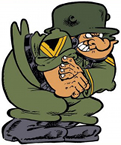beppi
Posts: 382
Joined: 3/11/2004
From: Austria
Status: offline

|
quote:
ORIGINAL: Nemo121
Question: ( just to help me get my head around it ).
If there are 50 flights of fighters ( say 400 planes with 8 planes a flight ) and 400 bombers in 100 flights do 50 flights of fighters (400 fighters) engage 50 flights of bombers (200 bombers)?
If so, once all of the bombers are shot down ( let's assume each firing pass results in a kill to keep things simple ) do the 50 flights look for more bomber flights to attack or is each flight "exhausted" by combat with an enemy flight?
I'm asking because clarifying this is going to really help make any testing more valid and, obviously, it wasn't working quite the way I initially read it.
I just again want to "comment" you post. I am quite sure that Michaelm will respond to your post and i hope you do not have a "problem" with me commenting it. But usually it is easier to if you use extremes to show how it works.
Assume you have 8 fighter on CAP. The fighters are superhuman, indestructible, always hit, always kill, cannot be damaged and so on. Just superhuman. They are in range, they always engage and so on. And they always kill.
Assume we have 800 bombers coming in. They are put into 100 groups.
So out CAP group engages the first group of bombers. Shots down all 8. Then our cap group engages the next group. Shots down all 8. Continue that for 100 "passes" until all incoming bombers are shot down.
From my understanding a firing pass is not actual a "firing pass". Instead it is a round of combat with 8 planes against 8 planes. As soon as two groups engage the actual combat kicks in. So they climb, drop, evade, accelerate, are in position, are out of position, shoot, hit, miss, suffer lack of fuel, suffer lack of ammo.
If you have time try a test with a lot of groups of fighters with enough forward firing guns, 99 accuracy, 99 effect, enough speed, 99 exp pilots, 99 AA skill, 99 durability against a group of bombers with no defensive guns, 1 durability, nor MVR (1), 1ex pilots, 1 AA skill. Just test the best against the worst. Then in theory it should be possible to shoot down > 200 planes. I will test it, but i cannot do it today.
In general a quite good model of combat. Problem i see is the factor "time" which is not really taken into account and this results in the "200 firing passes."
Actually i am no sure if it is even possible to implement but some sort of combat slots would be better.
As example:
We have 400 bombers coming in. We put them into 50 groups of 8 planes.
We have 400 fighers in cap. We put them again into 50 groups of 8 planes.
Detection range is 60 minutes. A combat slot is assumed as 10 minutes. And we have
I only take into account the combat until the target is hit. I do not take into account the 60 minutes it takes for the attacking planes to actual leave again. (Then you would have 13 slots -> 60 minutes to the target, 60 minutes to leave.)
So we have 7 time groups. The first time group are plane groups which are in range at the begin (T0). Second group is planes which are in range at T10. Third group are in range at T20. 6th group are in range at T60 (end of combat). 7th group are planes which do not participate.
So lets assume:
We have 10 groups (80 fighers) which are in range at T0(0 minutes -> detection until 9 minutes)
We have 10 groups in T10. 10 groups in T20, 10 groups in T30. 10 groups in T40, 10 groups in T50, 10 groups in T60 and 20 groups in T70 (which will never reach the incoming planes only on the approach).
So combat starts.
The 10 groups in T0 have 10 passes on the incoming planes. All other planes are out of range.
Lets assume, 2 groups get completely disabled (all planes out of fuel, out of ammo, destroyed, damaged). 8 groups still have combat ready planes. After all 10 groups have done their pass (or combat slot) the remaining 8 groups which are still combat worthy are added into the group T10.
Then T10 starts. We now have 18 groups in T10. So we have 18 firing passes (8 from T0, 10 from T10). After the combat 5 groups which started the combat at T10 are no longer combat worthy and 2 groups which started at T0 leave combat. So at the end of T10 we have 11 groups lefts (6 which entered combat at T0, 5 which entered at T10). So at the end of combat -> we put the 11 groups into T20.
Then T20 starts. Now we have 21 groups in T20 -> so 21 firing passes.
And so on and so on.
That would allow a dynamic system which does not kill small style combat and works in large style combat. Have doubt that i ever will get implemented and again i know that i am "oversimplifying" the problem cause there is much more which needs to be taken into account. I think such things would need a "WITP Grand Admiral Edition".
For me the basic problem is that you cannot squeeze a dynamic outcome of individual events into one fixed value.
< Message edited by beppi -- 1/25/2012 5:49:46 PM >
|
 Printable Version
Printable Version









 It's over when it's over.
It's over when it's over. 





 )
) 
 New Messages
New Messages No New Messages
No New Messages Hot Topic w/ New Messages
Hot Topic w/ New Messages Hot Topic w/o New Messages
Hot Topic w/o New Messages Locked w/ New Messages
Locked w/ New Messages Locked w/o New Messages
Locked w/o New Messages Post New Thread
Post New Thread